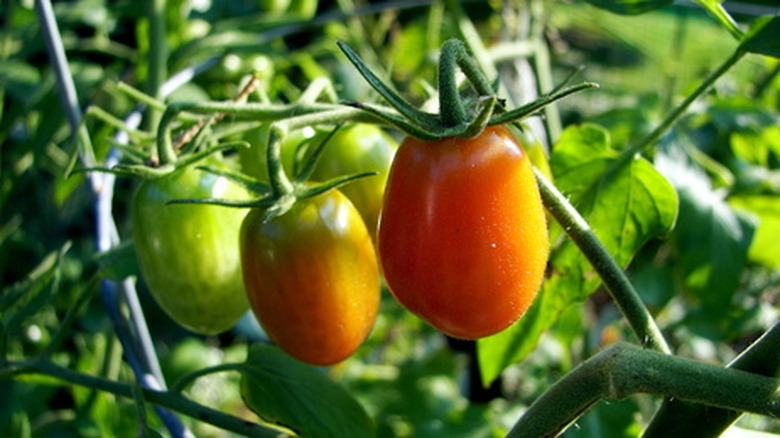Rotation Of Tomato Plants
Gardeners who practice crop rotation often are working in poorer soils or planting crops that are heavy feeders of specific nutrients. Rotating your tomatoes and other vegetables will help keep the soil producing well and ensure that each plant has the nutrition it needs. Tomatoes should be moved or rotated each year, which works well for most gardeners because they are annuals in most climates.
Significance
The principle of crop rotation is to make sure that the nutrients in the soil are replenished over time, as a different crop is planted on the soil, using different nutrients. Rotating tomatoes also will prevent them from contracting soil-borne diseases, fungi and pests. Keep in mind that for disease prevention and soil strength, the whole family of Solanaceae has the same characteristics–and often diseases–as tomatoes. These include tobacco, peppers, potatoes and morning glories, so don't plant these as a rotation from tomatoes. Instead, choose grains or legumes to rotate tomatoes with.
- Gardeners who practice crop rotation often are working in poorer soils or planting crops that are heavy feeders of specific nutrients.
Other Crops
You will want to rotate tomatoes with a soil-building crop such as rye, or a nitrogen-fixing crop like beans or peas. Rye is a good example of a winter cover crop, planted in the fall and plowed under in the spring before you plant your vegetables again. It enriches the soil when it is plowed under, and keeps down weeds, erosion and nutrient loss through the winter. On the other hand, nitrogen-fixing crops should be planted in a location where tomatoes or other heavy feeders were placed the previous years. They attract bacteria to the soil that "fix" nitrogen and ammonia in the soil so it is again rich for the next planting of tomatoes.
Time Frame
It's probably safe to return tomatoes to the same spot after three years in which the spot was either fallow–not growing anything–or growing other plants. However, move tomatoes yearly. This means you will have four different locations to rotate tomatoes through. The three-year method is good for most commonly grown crops, if you have enough space to do it. Every other year is possible, if you are very cramped for soil space, but this is not as good for the plants and the soil, and you risk blights and fungi on your tomatoes.
- You will want to rotate tomatoes with a soil-building crop such as rye, or a nitrogen-fixing crop like beans or peas.
- Every other year is possible, if you are very cramped for soil space, but this is not as good for the plants and the soil, and you risk blights and fungi on your tomatoes.
Geography
Tomato rotation does not depend on geography; it's a good idea in every climate. However, your method of rotation may be very different based on your growing season. Warm-climate farmers and gardeners will find that planting a cover crop along with tomatoes is a more efficient method of rebuilding the soil, as the cover crop will have the winter to thrive as well. On the other hand, warmer climates often mean a wider range of diseases to avoid with proper rotation. In colder areas, a winter crop may not be as successful if the winters are harsh and long, but most diseases will be killed by the winters.
Considerations
Getting a good crop rotation going in home gardens can be demanding. You may find you have to dig a new garden bed or create new raised beds or containers in order to really rotate your crops. A small garden patch, after all, often has the soil all turned up together in the spring, and moving tomatoes only a few feet won't do much good. For this reason, some gardeners simply plant their tomatoes in pots or containers every other year or every three years, depending on the space you have available. But getting into the habit of rotating all your crops, and creating a workable system to do it, will benefit more than just your tomatoes.
- Tomato rotation does not depend on geography; it's a good idea in every climate.
- Warm-climate farmers and gardeners will find that planting a cover crop along with tomatoes is a more efficient method of rebuilding the soil, as the cover crop will have the winter to thrive as well.
